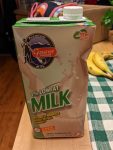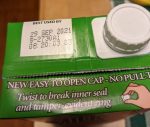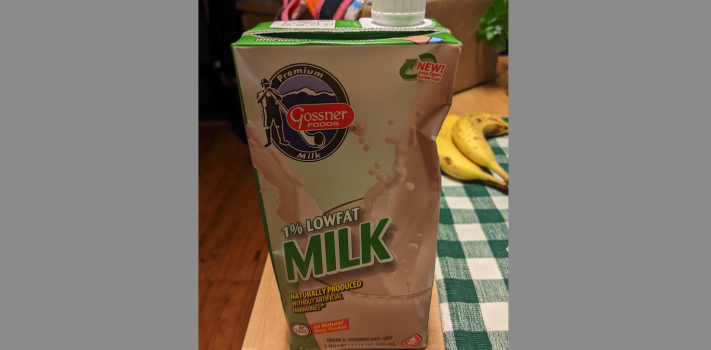Icy gusts of January wind were driving sheets of snow relentlessly across the slick pavement. I was cautiously creeping along in my car, making my way home from work. The weather forecast for the coming night was threatening.
As I drove past a grocery store, the gloomy winter twilight revealed a crowded parking lot. Shoppers were flocking to the store to buy the remaining stocks of bread, milk, and other supplies in anticipation of being snowed in.
I was able to drive right on by the store without the need to stop. My wife, “Kari” had stocked our pantry well for short-term shutdowns. It had things like beans and canned meat, pilot bread and rice, canned fruit and summer sausage, peanut butter and fruit juice, pancake mix and muesli. And to mix up those pancakes or pour over that muesli, there were quarts and quarts of shelf-stable UHT milk. Like the Proverbs 31 woman, Kari was not afraid of snow for her household.
What is UHT Milk?
“UHT” stands for “Ultra High Temperature”. UHT milk is processed at temperatures in excess of 275 degrees Fahrenheit. Traditional pasteurization only heats milk to 161 degrees Fahrenheit.
The UHT process slightly changes the protein structure and the taste of the milk. My grandkids don’t like it, and it is not my first choice to accompany a fresh baked chocolate chip cookie. But when UHT milk is poured over a bowl of cereal, I would be hard-pressed to tell the difference from regular milk. And I sure like the taste of UHT milk a whole lot better than the taste of reconstituted powdered milk.
The UHT process was perfected by Tetra Pak in Sweden in the 1950s and 1960s. It is extremely popular in many parts of the world. For example, 96.7% of the milk consumed in Belgium is UHT processed milk.
 UHT milk began to be sold in the United States by the Parmalat company in 1993. Many UHT milk products in the United States are sold refrigerated, even though this is totally unnecessary. Americans seem to have a deep-seated suspicion of unrefrigerated dairy products. Many UHT milk products are flavored, such as chocolate milk or strawberry milk. The flavoring helps to mask the slightly different taste of the UHT milk that forms the base of these products.
UHT milk began to be sold in the United States by the Parmalat company in 1993. Many UHT milk products in the United States are sold refrigerated, even though this is totally unnecessary. Americans seem to have a deep-seated suspicion of unrefrigerated dairy products. Many UHT milk products are flavored, such as chocolate milk or strawberry milk. The flavoring helps to mask the slightly different taste of the UHT milk that forms the base of these products.
Our Experience with UHT Milk
Kari buys our UHT milk at a local “dollar” store. I put “dollar” in quotes, because due to inflation, each item in the store now costs $1.25 . We usually buy our UHT milk as 1% lowfat milk, although skim, 2%, and whole milk are also available locally.
When we buy UHT milk, the expiration date is usually 6 to 12 months from the time of purchase. I have often used UHT milk many months after the marked expiration date, and have never yet had any go bad.
 Recently, I used a carton of UHT milk that had been forgotten in our camper last summer. It expired 9 months prior to use. It sat on a shelf in our camper through the heat of the summer, and the cold of the winter. The carton was bounced around in the cupboard, battered and dented, but the seal was not broken. The milk still tasted just as fresh as if it had just come off the line.
Recently, I used a carton of UHT milk that had been forgotten in our camper last summer. It expired 9 months prior to use. It sat on a shelf in our camper through the heat of the summer, and the cold of the winter. The carton was bounced around in the cupboard, battered and dented, but the seal was not broken. The milk still tasted just as fresh as if it had just come off the line.
Uses
UHT milk is not intended for long-term storage, since it has a shelf life of only about a year.
Powdered milk products are better suited for medium-term storage. The USDA claims that non-fat dried milk can be stored indefinitely. A shelf life of about a decade is probably more realistic.
Owning a cow or goat may be the best solution for providing drinkable milk during a truly long-term disruption. But for short-term emergency use, UHT milk is very convenient.
For example, when Kari and I had Covid, it was good to know that we had milk if we needed it even though we could not go to the store.
It is also handy for trips with our camper. Refrigerator space in the camper is at a premium. It is nice that we can keep most of the UHT milk unrefrigerated, except for the one quart we have open at any one time.
The verbiage on the packaging of the UHT milk that we buy suggests that it a good choice for breakfast, school lunch, hiking, biking, camping, travel, food storage, and emergency preparedness.
The Gossner Brand
The particular brand of UHT milk that our dollar store carries is produced by Gossner Foods, Inc. of Logan Utah.
Gossner Foods was established by a Swiss immigrant cheese maker in 1966. Since milk deliveries from their dairy farmers fluctuated seasonally, Gossner Foods began producing UHT milk in 1982 to assure a consistent supply of milk for their cheese-making. When there was a surplus of milk, it was preserved as UHT milk. When there was a shortage, Gossner drew on their UHT reserves to maintain production levels. Eventually, they began packaging extra UHT milk for sale to consumers as well.
The cartons that we buy measure approximately 7.75 X 3.5 X 2.25 inches. They are waxed cardboard Tetra Pak cartons with screw off lids.
At the time of this writing, Gossner Foods produced UHT milk as whole milk, 2% milk, root beer flavored milk, whipping cream, 2% chocolate milk, 1% milk, 2% cookies and cream flavored milk, 2% strawberry flavored milk, whole chocolate milk, 2% banana milk, skim milk, and 2% orange cream milk.
Further information about Gossner Foods UHT milk and other products is available at www.gossner.com.
Milk as a Source of Nutrition
Human breast milk contains almost every nutrient the human body needs. The milk produced by mammals such as cows, sheep, goats, and yaks is similar but not identical to human milk. The consumption of milk provides water, protein, fat, carbohydrates, vitamins, and minerals.
Not every culture in the world uses milk or other dairy products as a source of nutrition. I remember preaching a sermon once when I was overseas as a missionary. I asked the congregation, “What is the most disgusting thing that you can think of?” If I remember right, I was trying to illustrate Jesus’ feelings about the lukewarm church of Laodicia in Revelation 3:16. I was expecting an answer like “Finding half of a worm in an apple that I have just taken a bite out of.” I was surprised when one member of the congregation quickly replied, “Butter!”
The huge differences in regional dairy use may be partly due to an interrelated combination of tradition and genetics. I would hesitate to say which came first, the chicken (tradition) or the egg (genetics). It is possible that people groups that had a genetic predisposition to be able to digest dairy products well had a good enough experience with milk to develop a tradition of consuming dairy products as a part of the adult diet. On the other hand, it is possible that people groups that developed a tradition of utilizing milk as a part of the adult diet through that tradition favored the reproduction of those who could digest dairy products better (a potential mate who was not experiencing abdominal upset was more desirable). However, the interplay of tradition and genetics alone is not sufficient to explain this phenomenon. There are many cultures, such as the tribal groups of the steppe of Kazakstan, Russia, and Mongolia, who consume large amounts of dairy products even though they are lactose intolerant.
In any case, the vast majority of children worldwide are able to digest lactose, the sugar found in milk. As they grow older, many children begin to lose this ability, beginning at about five years of age. More than 90% of adults in Northern Europe can digest milk products well. More than 90% of adults in Southeast Asia cannot. People groups in the rest of the world tend to fall somewhere between these two extremes.
Milk as a Luxury and as Survival Food
The children of Israel living as impoverished slaves in the land of Egypt enjoyed drinking milk, but seldom had the opportunity to do so. When God sent Moses to deliver them from bondage into the blessings of the land of Canaan, He described the promised land as a “land flowing with milk and honey” (Exodus 3:8, 17; 13:5; 33:3; etc.).
Many centuries later, God spoke to the Prophet Isaiah about the aftermath of the coming Assyrian invasion of Judea. God promised that He would sustain the survivors by causing the reduced herd of livestock to produce an abundant supply of milk (Isaiah 7:21-22).
The high-quality nutrition provided by dairy products can enhance the chances of survival in a crisis situation. On the other hand, the necessity of protecting the livestock that provides dairy products from thieves may conversely diminish the chances of survival in a crisis situation. Throughout history, many lives have been lost protecting livestock. For example, the Bible records how the Sabeans, Chaldeans, and fire from heaven destroyed Job’s servants while they were protecting livestock, and thus left him impoverished (Job 1:14-17).
Conclusions
UHT milk is an excellent nutritional resource for short-term emergency situations. It does not require refrigeration prior to opening, and has a shelf life measured in months rather than days or weeks.
For emergency situations lasting years rather than months, powdered milk is probably a more effective, albeit less palatable solution. Emergency situations lasting decades probably require recourse to animal husbandry, or transition to a dairy-free diet.
Disclaimer
I did not receive any financial or other inducements to mention any vendor, product, or service in this article.










